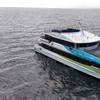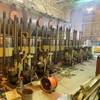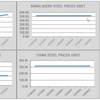Historic Containership Contract for China
The new generation of 10,000 TEU container vessels contracted in China by Seaspan represents major improvements in energy efficiency, cargo capacity, operational efficiency and emission reductions. The new features have been developed in a collaboration between Seaspan, the Yangzijiang Shipbuilding Group, MARIC and DNV. The order for seven 10,000 TEU container vessels plus 18 options which was signed in Shanghai on June 8, 2011 is the biggest ever container contract entered into in China. The vessels will be built to DNV class.
The improvements due to new design features are substantial. The cargo capacity is increased by 10% while the fuel consumption is reduced by 20%. The new hull design enables the vessels to carry minimum amounts of ballast water while in operation. The vessels are designed to reduce the emissions to air by approximately 20% in order to meet the future regulatory emission requirements. This follows Seaspan’s three-year SAVER (Seaspan Action on Vessel Energy Reduction) programme aimed at improving cargo uplift, reducing fuel consumption and improving operational performance.
“The SAVER 10,000 TEU vessels embody Seaspan's long-term focus on and philosophy of providing the market with increasingly efficient vessels and retaining Seaspan's leadership in this area. We were leaders in introducing post-8,000 TEU vessels, we promoted slow steaming back in 2006 and we are now presenting a next-generation product that provides for a paradigm shift in the performance of the larger-size container ships,” says Peter Curtis, Vice President of Seaspan Ship Management Ltd.
“In this economic climate, where it really is a buyer’s market, the time is ripe to push for technological improvements. We are fortunate to have found a like-minded shipyard and design partners in Maric and DNV,” says Mr Curtis.
The ship hull lines have been optimized for a speed range of 18-22 knots. In this range, the fuel consumption has been reduced by 16-27% compared to contemporary similar-size ship series presently operated by the industry. The new SAVER design is also capable of reaching 25 knots as the focus on schedule reliability is expected to increase.
The new trend reflects the operational profile of the liner companies. Slow steaming will continue, depending on the market situation and the value of goods carried on board. Most container vessels will operate at a range of speeds and must do so using as little fuel as possible.
“These new container vessels have exciting new features that make them efficient, cost effective and more environmentally friendly. We’re proud to have been involved in developing this new generation of container vessels,” says Remi Eriksen, Head of DNV’s Division Asia, Pacific and the Middle East. He adds that DNV will do its utmost to provide quality and professional class services to this project.
The new 10,000 TEU container vessels have been developed in close cooperation between the Yangzijiang Shipbuilding Group, the Marine Design and Research Institute of China (MARIC), the owner Seaspan and DNV.















